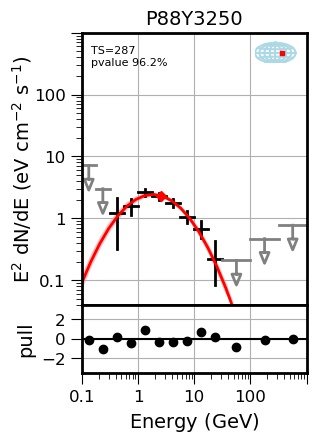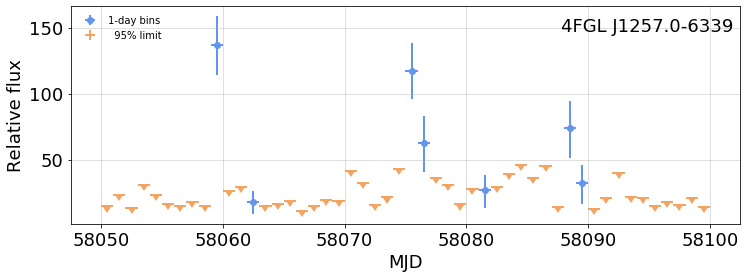from wtlike import *
from utilities.ipynb_docgen import *
source_name = '4FGL J1257.0-6339'
def P88Y3250( clear=False):
r"""
## Variability analysis of 4FGL J1257.0-6339
{date}
This source, ~$0.5^\circ$ distant from PSR B1259-63, has a nickname P88Y3250.
I look at it because it was flagged as variable, index=48.3, so may affect B1259.
It is unassociated, with a pointlike TS=287, and flux uncertainty of 0.7%. Its 12-year SED is:
{sed}
{out1}
{out2}
Here is the light curve, measured in weekly intervals.
{fig1}
Note that most of the weeks are limits, except for a few quite significant ones.
The blue line is the result of the Bayesian block (BB) analysis, which found several blocks.
The BB fluxes with relative flux >2:
{bbflux}
Here is a an expansion, in daily bins, following the 2017 B1259-63 periastron at 58018:
{fig2}
### Comparison with the [LightCurveRepository](https://fermi.gsfc.nasa.gov/ssc/data/access/lat/LightCurveRepository/).
{lc_image}
This shows the energy flux for 3-day intervals, and appears to be consistent with the wtlike analysis.
### Conclusion
This source is not variable--the apparent variability is entirely due to the flares from B1259-63.
"""
sed = image('P88Y3250_sed_uw1216.jpg', width=250, caption=None)
with capture_print('Output: load data, add weights, form time bins, fit') as out1:
weekly = WtLike(source_name)
with capture_print('BB partition output') as out2:
bbview = weekly.bb_view()
fig1 =figure(
bbview.plot( yscale='log', ylim=(0.5, 200), ts_bar_min=4, figsize=(20,4)),
width=600, )
bbflux = monospace(bbview.fluxes.query('flux>2'))
with capture_print() as out3:
fig2 = figure(
weekly.view((58050, 58100,1)).plot( fignum=2),
width=600)
lc_image=image('P88Y3250_light_curve.png', width=600, caption=None)
return locals()
# runs the above, generates the doc
nbdoc(P88Y3250, clear=False)
Implications for the Catalog
This could be done with all 4FGL sources with a relatively small amount of effort.
Computing times to generate this:
- 15' using pointlike to generate a table of weights for energy- and angle- regions
- 10' to load photons in the source region from the compressed FT1/FT2 table for the 11 2/3 years, and apply weights using the associated table.
What would be needed:
- a systematic effort to produce such tables, using the official catalog model with fermipy for all sources.
- Compare all lightcurves for nearby sources to check correlations: for such pairs, or groups, identify which is the culpit, and modify the background assumption for the neighbors.
- A modification of wtlike to change the current background assumption, allowing it to have a fixed and a variable component
Potential result: Detailed, and more reliable, light curves on any time scale for all sources.
Can I enlist volunteer(s)? This especially applies to #1.



